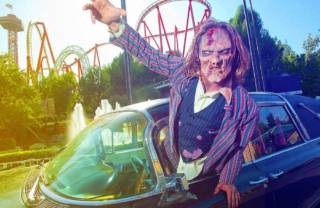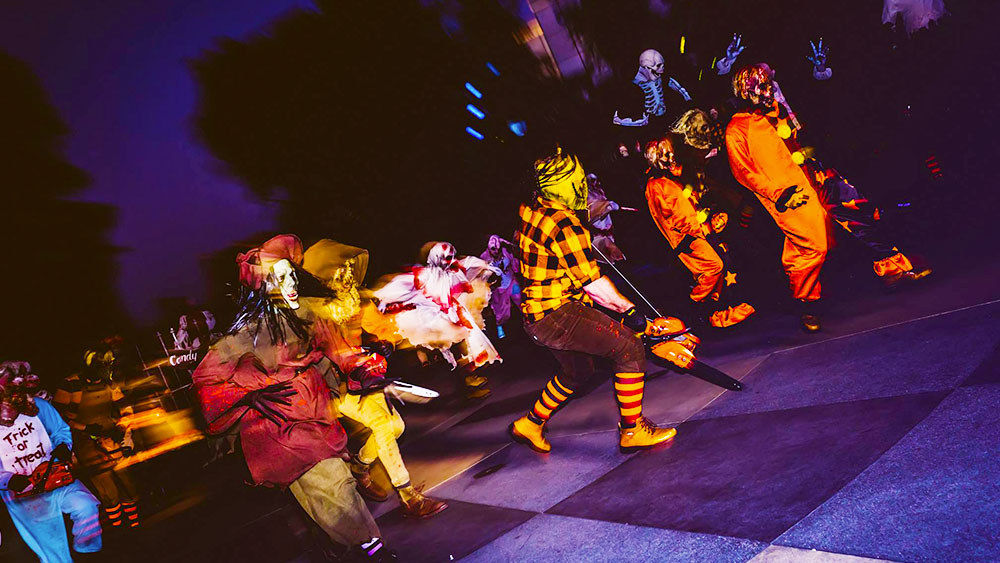When it comes to the Halloween season, spook-starved inhabitants apparently have an uncontrollable appetite that constantly needs to be satiated.
The National Retail Federation forecasts that 179 million Americans will spend a new high of $9.1 billion for Halloween-related festivities across all purchasing categories this year, an increase of $700 million from the previous record set last year.
As the horror-themed holiday season keeps bleeding more into September, theme parks continue to shape fright-filled experiences, from securing exclusive IP to having one-to-one dialogue with the community, to capitalize on revenue streams for the fertile market.
The big four—Disney, Cedar Fair, Six Flags and Universal Studios—all have their own branded variation of Halloween-themed attractions as soon as the leaves begin to fall each autumn.
Six Flags is celebrating by startling horror fans across its theme parks with Fright Fest for the twenty-fifth consecutive year this season with properties like Suicide Squad and a variety of other attractions, mazes and even a night club.
James Geiser, vice president of marketing and sales for Six Flags, says Halloween has become such a huge event and cause for celebration that it’s grown from a single day at the end of October to some retailers launching campaigns immediately after Labor Day.
“Since Six Flags owns the biggest, scalable event across North America, and we’re able to deliver co-branded marketing programs with huge brands like Coca-Cola and Mars,” Geiser told AListDaily. “We provide brands who might have a Halloween specific campaign the opportunity to reach the family audience through sampling, and we also work with brands targeting consumers who are 18-and-over by creating custom content across our Nielsen-measured digital network. All of these touchpoints drive awareness and engagement throughout the run of Fright Fest.”

Six Flags, who reported $580 million revenue for the recent quarter, an increase of $23 million to the same period last year, looks for the best brand fit based on common strategies and goals. For Coca-Cola, the Snickers-sponsored Fright Fest partnership made perfect sense, Geiser said.
“Coca-Cola’s goal is to connect with teens in an authentic and engaging manner. Those teens are fans of our brand and Fright Fest in particular,” he said. “From there, we look for common space to activate the brands and promote the in-park experience. It’s really a win-win all around.”
To retool their storytelling and marketing strategy each year, Geiser said the Six Flags creative teams work on content both from an entertainment perspective and on the communications front, looking at current events, along with trending topics and interests to build unique concepts and experiences. One creep area the theme park is capitalizing on is the current captivation for clowns as well as featuring scareactors in advertising.
“Six Flags owns the thrill space for theme parks, and Fright Fest provides the perfect opportunity to scare people in a fun and thrilling kind-of-way,” Geiser said. “We don’t take ourselves too seriously and we encourage our creative teams to have fun with this event. Great ideas come from everywhere, including our guests and employees. We keep it fresh by updating the scare factor every year. Research has told us our guests want it scary, so we plan to over-deliver on that front.”
As for the actual marketing of Fright Fest, Geiser said Six Flags continues to see social media playing a key role in driving awareness and demand. The media teams are focused on Instagram and Facebook to drive campaigns.
“While the platforms themselves are not new, the way we’re using them is,” Geiser said. “We’re developing our ads to feature social content using tailored creative for the platform. We want to startle people as they’re scrolling across their news feed. In addition, we’re using data better than ever to prospect for new guests and connect with existing ones.”
Another theme park leveraging a strong social media strategy is Universal Studios.
John Murdy, creative director of Halloween Horror Nights at Universal Studios Hollywood, has year-long, one-on-one conversations with consumers by personally running the Halloween Horror Nights Twitter account. His tone and approach on the platform includes building relationships by sharing behind-the-scenes content and insight into how the event is created.
“Our fan base is not shy. They like to suggest properties we should be doing. Halloween Horror Nights is super important to our fans—more than you would ever think,” Murdy told AListDaily. “Their passions fuels us. Horror is cyclical and goes through phases, so I solicit their opinion and ask them what they’d like to see to stay one step ahead. A lot of times, we get a temperature check on the brand just by the reaction we see on social and their desire to see certain things. That very much informs what we do. There are several properties that we’re in negotiations now for the future that we can very much attribute to the fan base.”
Murdy says the Twitter community literally demanded he look into Insidious. The back-and-forth dialogue made him realize how much the community cared about the property. Coincidentally, contemporary horror films producer Jason Blum wanted to work with Murdy and Universal too, and so the journey started. This year they gave birth to “The Horrors of Blumhouse,” mazes inspired by the The Purge franchise, Sinister movies and the recently released Happy Death Day.
“Our vision for this event since day one is that we’re going to work with the biggest brands in the world of horror—and we’re going to create living horror movies that are coming after you,” Murdy said. “Being the studio that invented the horror movie, we’ve been true to that brand.”
Blum pitched the idea of a compilation maze based on his films and then left the rest to Murdy and his team at Universal to decide what that iteration and inspiration should be. Both Murdy and Blum came to the agreement that mazes serve as the best form of marketing for a moviemaker because consumers get to the live through the films first hand.
“From a movie or TV marketer’s perspective, you’ve got a massive number of people from the same demographic that you’re trying to reach—and you can touch them all at the park with a physical and visceral experience through a maze,” Murdy said. “In my mind, it’s the best possible way to promote a property and get people excited about it. That’s pretty exciting for our fans, because the mazes turn into the ultimate live-action trailer for the movies.”
Insidious does not hit theaters until January, and Happy Death Day was released in the middle of Halloween Horror Nights, so fans are getting a chance to live through the experiences before potentially seeing it on screen. Universal has also experimented with other interest areas like the Black Sabbath rock and roll maze in 2013. Murdy said that the filmmakers he works with are naturally horror buffs themselves and for the most part, frequent Halloween Horror Nights each year.
“We get in on the ground level with the moviemakers,” Murdy said. “I’m reading scripts at the early stages practically before everyone. We have a comfort level between us because it’s a mutually beneficial relationship. We get great content for our event and they get an audience excited about a property. When we start the design and publicity process we always approach it as year one. We don’t ever get to a place where we’re comfortable and say ‘we got this.’ It’s always about being hungry and taking it to the next level no matter how successful the event has been before.”

